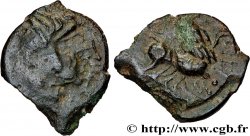Live auction - bga_379162 - GALLIA - BITURIGES CUBI (Area of Bourges) Potin au bucrane et au cheval
得先注册又得到批准才可以报价。为了报价注册. 客户应该得到公司允许,那种过程需要 48 个小时。别等出售结束那一天才登记。您报价的话等于您赞成买那物品,而且按« 保价 » 证明您接受 cgb.fr 因特网拍卖使用法.
报价时只可以出全数值欧元总额。物品描述也说明销售结束时间,结束后出价都不会生效。 报价命令转达有时变动,等到最后秒钟增加否决的可能会。想多了解的话请注意 因特网拍卖常问
最高出价方将支付18%的不含税的拍卖费用
最高出价方将支付18%的不含税的拍卖费用
| 估算 : | 600 € |
| 价格 : | 260 € |
| 最高出价 : | 280 € |
| 拍卖结束日期 : | 01 March 2016 15:26:47 |
| 竞拍人 : | 2 竞拍人 |
种类 Potin au bucrane et au cheval
日期: Ier siècle avant J.-C.
材质 potin
直径 19,5 mm
模子方针 3 h.
重量 2,75 g.
稀少度 R3
关于品相的说明
Potin exceptionnel, avec de beaux reliefs pour ce type. Patine sombre et brillante, sur un flan un tout petit peu irrégulier
正面
正面的文字 ANÉPIGRAPHE.
正面的说明书 Bucrane accosté de deux esses, une croisette entre les cornes ; un grènetis en descendant d’une corne à l’autre et bourrelet périphérique.
背面
背面的文字 ANÉPIGRAPHE.
背面的说明书 Cavalier (?) à gauche ; grènetis perlé et bourrelet périphérique.
评论
Ce potin est très rare ; seulement connu par un exemplaire au musée de Zurich et de très rares en collections privées, c’est la seconde fois que nous le proposons à la vente après le bga_364110 de CELTIC 9 et nous n’en avons jamais vu passer d’autre en catalogues !
Le prototype du droit est clairement le potin des Rèmes au bucrane, lui-même inspiré du rare sesterce de Caius Antius Restio frappé vers 45 avant J.-C. Le revers au cheval n’a rien à voir avec l’ours du potin des Rèmes.
Le cavalier supposé n’est pas visible sur le n° 275 de Zurich (lui-même repris en dessin par A. Gaumann pour son n° 176). Le n° 24.5 de H. Patat correspond à notre monnaie, mais le cavalier pourrait n’être qu’une interprétation à partir de globules qui auraient fusé entre eux....
Le prototype du droit est clairement le potin des Rèmes au bucrane, lui-même inspiré du rare sesterce de Caius Antius Restio frappé vers 45 avant J.-C. Le revers au cheval n’a rien à voir avec l’ours du potin des Rèmes.
Le cavalier supposé n’est pas visible sur le n° 275 de Zurich (lui-même repris en dessin par A. Gaumann pour son n° 176). Le n° 24.5 de H. Patat correspond à notre monnaie, mais le cavalier pourrait n’être qu’une interprétation à partir de globules qui auraient fusé entre eux....








 对产品描述纠错
对产品描述纠错 打印
打印 分享我的选择
分享我的选择 提问
提问 Consign / sell
Consign / sell
 产品介绍
产品介绍















